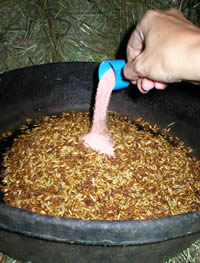Your horse needs supplementary electrolytes during hard work or hot weather…

- as a general rule, whenever he’s under unusual stress. This may include long trailer rides (of one hour or more), particularly if he’s not accustomed to hauling, or if the weather is 80 degrees Fahrenheit or hotter.
- when he works in conditions — heat plus high humidity — that make it extra-difficult for him to dissipate body heat.
- when he sweats profusely.
- when he works harder or longer than he’s accustomed to.
I don’t recommend giving your horse electrolytes — except free-choice salt — on a daily basis when he’s not in hard training or otherwise under stress; daily extra calcium can actually impair his ability to mobilize calcium from his reserves when necessary. But if you’re not sure whether he’ll need supplementary electrolytes for a possible stressful activity, go ahead and give them. If you use an appropriate electrolyte source at the recommended dose, he’ll harmlessly eliminate whatever he doesn’t require.
What ingredients should supplementary electrolytes contain?
Check the label carefully. Look for chloride and/or acetate combinations such as sodium chloride, calcium chloride or calcium acetate, potassium chloride; these are quickly and easily absorbed. Avoid products that use di-calcium phosphate (which horses don’t absorb very well) and those that list sugar, dextrose or corn syrup as the first ingredient.
Important: Electrolytes containing bicarbonate are formulated for horses with diarrhea. These can be harmful when used as an electrolyte supplement for stress and exercise.
If you need to supplement your horse’s electrolytes and commercial products are unavailable, it’s possible to make homemade electrolytes by combining “lite” salt (an excellent source of potassium and chloride) with sources of calcium and magnesium such as Tums. However, these formulas aren’t absorbed as well as the commercial ones.
Paste or powder?
I use the powdered form of Endura Max electrolytes. I mix 2 ounces (3 ounces on a really hot day) with water, applesauce or fruit-flavored yogurt; the sealed, single-serving cups are handy for taking on the trail. I squirt this slurry directly into my horse’s mouth with a re-usable 60-cc dose syringe that has a blunt “catheter” tip. You can add powdered electrolytes directly to your horse’s feed when supplementing before or after a ride — but only if you’re absolutely sure he doesn’t mind and will finish his ration.
Electrolytes are also available in paste form in ready-to-use disposable dose syringes (similar to those used for wormers). These are generally more expensive per dose than the powdered electrolytes, but they’re easy to pack on a long ride. Again, be sure to check the label for the contents.
When to Give Electrolytes
- An hour or two before your horse comes under stress from hauling or working. If you’re hauling to a trailhead, give electrolytes before you load, then again before you start your ride if you hauled for an hour or more.
- During prolonged stress:
*On long hauls stop about every three hours to offer your horse some water and give him a chance to urinate, which is difficult for him to do in the moving trailer. Then give him electrolytes.
*On long trail rides give electrolytes every three or four hours. If temperature and humidity are unusually high for your horse (because, for instance, he’s usually stabled during the heat of the day and turned out at night, or it’s an unseasonably hot early spring day, and he hasn’t yet finished shedding out), or if the terrain is more difficult than he’s used to, he’ll need electrolytes even during a shorter ride of two or three hours. This includes conditioning rides: If you’re not using a heart monitor to gauge how hard he’s working and how well he’s recovering, watch for outward signs of stress — rapid breathing and constant sweating.
At a rest stop, offer water and food first so he has a good opportunity to drink and eat first without the taste of salt in his mouth; save the electrolytes until you’re ready to start out again. If he’s been sweating freely yet won’t drink or eat when you stop, he may already be in distress. Give him electrolytes, then let him rest — preferably out of the sun — while his body chemistry rebalances itself. If possible, help him cool by sponging him with water. You can continue the ride if his appetite returns within about fifteen minutes. If it doesn’t, walk slowly back to the trailhead. - Finally give electrolytes after the work or other stress is done.
Active endurance rider Dr. Jeannie Waldron’s practice at Rectortown (Virginia) Equine Center specializes in sporthorses and lameness. She also has an abiding interest in the metabolics of endurance horses.
This article is excerpted from “Electrolytes to Beat the Heat” in the August 2001 issue of Practical Horseman magazine.

